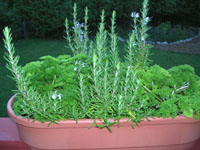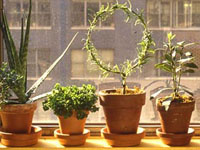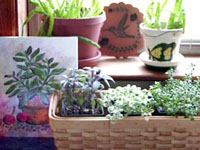Just because it's winter, doesn't mean you have to stop growing food. While it might be cold and blustery outside, there are a number of edible plants you can grow indoors. Some of my favorites are herbs. Growing herbs indoors successfully is all about selecting the right varieties and having the right conditions to grow them. You can go two ways with indoor herbs: (1) start new plants from seed or buy transplants to grow inside, or (2) bring mature annual or perennial herbs into the warmth of your home. I like doing a little of both.
Here are some tips for growing herbs inside in winter. I hope it inspires you to give it a try.
Bringing Herbs Indoors
Window boxes filled with rosemary and parsley can be moved inside before freezing weather.
You can grow many herbs in pots outdoors in summer and fall, and bring them indoors before a killing frost. Some of my favorites to grow this way are parsley, rosemary, and chives. There are a few things to keep in mind before you bring these herbs indoors:

Indoor herbs can be decorative as well as functional. Why not train a rosemary plant on a topiary frame for a whimsical look.
It's easy to grow fresh herbs from seed or seedlings on a windowsill or on a table. You just need the right materials.
Although a sunny window looks bright in winter, the available light can be only 1/10th of what's needed for plants to grow properly. That's why it's best to grow herbs under grow lights. Select full-spectrum lights and leave them on for 12 to 14 hours a day. Keep the tops of the herbs close to the bulbs and the plants should thrive.
After lighting, soil is next in importance. Grow seedlings in 3- to 4-inch-diameter pots and use only sterilized potting soil mixes that are light and airy. Many culinary herbs require well-draining soils so the lighter the soil the better.
Supplement the potting soil with a liquid fertilizer when watering. Use a half-strength formulation to encourage new growth. Water plants less often but more thoroughly, and only when the soil is actually dry to the touch. Add water until it drains from the bottom of the pot. Keep the air temperature on the cool side (60° to 65° F) for the best growth.

Although some herbs, such as chives, may grow well in a sunny window, most need grow lights to produce the most leaves.
Try growing these herb varieties. They have compact growing habits and pack a flavorful punch.
English mint (Mentha spicata) - Perhaps the best-behaved spearmint variety (not as invasive as others, and the leaves are broader and deeper green).
Spicy Globe basil (Ocimum basilicum minimum) - Dense, compact form of basil, 8- to 10-inches tall. The leaves are smaller than regular basil, but taste and smell great.
Blue Boy rosemary (Rosmarinus officinalis) - More compact and diminutive than standard rosemary, reaching a height of just 24 inches. Flowers freely and has excellent flavor.
Dwarf Garden sage (Salvia officinalis 'Compacta') - Smaller leaves and more compact than regular sage, growing only 10 inches high.
Stevia (Stevia rebaudiana) — Used as a natural sweetener, the leaves are 10 times as sweet as sugar. Purchase seedlings as seeds are difficult to germinate. Keep plants cool and the soil slightly moist.
For more on indoor herb growing: Charlie Nardozzi is an award winning, nationally recognized garden writer, speaker, radio, and television personality. He has worked for more than 30 years bringing expert gardening information to home gardeners through radio, television, talks, tours, on-line, and the printed page. Charlie delights in making gardening information simple, easy, fun and accessible to everyone. He's the author of 6 books, has three radio shows in New England and a TV show. He leads Garden Tours around the world and consults with organizations and companies about gardening programs. See more about him at Gardening With Charlie.
Charlie Nardozzi is an award winning, nationally recognized garden writer, speaker, radio, and television personality. He has worked for more than 30 years bringing expert gardening information to home gardeners through radio, television, talks, tours, on-line, and the printed page. Charlie delights in making gardening information simple, easy, fun and accessible to everyone. He's the author of 6 books, has three radio shows in New England and a TV show. He leads Garden Tours around the world and consults with organizations and companies about gardening programs. See more about him at Gardening With Charlie.
 Victory Seed Company has all the seeds you want for your best garden in 2024.
Victory Seed Company has all the seeds you want for your best garden in 2024.
For 25 years, the family-owned Victory Seed Company has provided the highest quality vegetable, herb and flower seeds to families across the country. We are passionate about providing you the best seeds available that give excellent germination, robust plants, and the harvest you want. With a catalog of over a thousand varieties, we have everything, and our prices are the kinds that we'd want to pay. We have hundreds of yesterday's heirloom vegetables, as well as today's award winning hybrid selections. Get to know us by visiting our website and browsing through our online vegetable seed catalog.